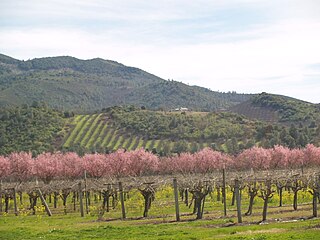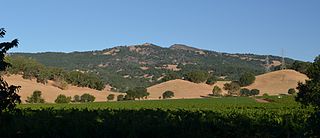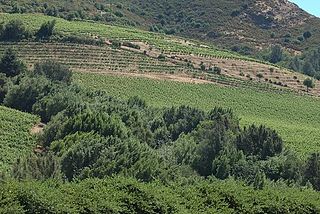Related Research Articles

Napa Valley is an American Viticultural Area (AVA) located in Napa County, California. It was established by the Bureau of Alcohol, Tobacco and Firearms (ATF) on January 27, 1981. Napa Valley is considered one of the premier wine regions in the world. Records of commercial wine production in the region date back to the nineteenth century, but premium wine production dates back only to the 1960s.

The Suisun Valley AVA is an American Viticultural Area in Solano County, California, located just east of the Napa Valley wine region in the Coast Range. It was established as a wine appellation on 27 December 1982.

Snake River Valley is Idaho’s first American Viticultural Area (AVA) that encompasses an area in southwestern Idaho and two counties in eastern Oregon. The area was established on April 9, 2007 by the Alcohol and Tobacco Tax and Trade Bureau (TTB), Treasury after reviewing the petition submitted by Idahoan vintners of the Snake River Valley, the Idaho Grape Growers and Wine Producers Commission, and the Idaho Department of Commerce and Labor, collectively acting as “petitioner” to establish the 8,263 square miles viticultural area named "Snake River Valley." For wines to bear the "Snake River Valley" label, at least 85% of the grapes used for production must be grown in the designated area, which includes the southwestern Idaho counties of Ada, Adams, Boise, Canyon, Elmore, Gem, Gooding, Jerome, Owyhee, Payette, Twin Falls, and Washington, and the Eastern Oregon counties of Malheur and Baker. The appellation, when established, was resident to 15 wineries and 46 vineyards with 1,800 acres (728 ha) under vine.

The Atlas Peak AVA is an American Viticultural Area located within Napa Valley AVA just northeast of the city of Napa. The appellation sits on a higher elevation than most of Napa's wine region which limits the effects of the cool fog coming in from Pacific Ocean. The westward orientation of most vineyards on the Vaca Mountains also extends the amount of direct sunlight on the grapes. The soil of this AVA is volcanic and very porous which allows it to cool down quickly despite the increased sunlight. The area has a fairly significant diurnal temperature variation upwards of 30 °F (17 °C) between daytime and night. This contributes to the balance of acidity that grapes from Atlas Peak vineyards are known to have.
Mount Veeder AVA is an American Viticultural Area located within Napa Valley AVA among the Mayacamas Mountains. The boundaries of this appellation include 25 sq mi (64.7 km2) with 1,000 acres (400 ha) planted on thin volcanic soil. Many vineyards are found on the steep mountain face some as steep as 30°. The steepness of the angle gives the vineyards benefits of more direct sunlight and better drainage.

The Oakville AVA is an American Viticultural Area located within Napa Valley AVA and centered on the town of Oakville, California. The appellation extends over a flat expanse of well-drained gravel soil between the Vaca and Mayacamas Mountains. Oakville AVA is known for its success with Bordeaux varietals, which have produced wines of rich texture, firm tannins, and notes of mint and herbs.

The Rutherford AVA is an American Viticultural Area located within Napa Valley AVA and centered on the town of Rutherford, California. The area is known for its unique terroir particularly with its Cabernet Sauvignon. The well-drained soil of this area is composition of gravel, loam and sand with volcanic deposits and marine sediments from the Franciscan Assemblage. The appellation accounts for only 6,650 acres (27 km2) in the center of Napa Valley but has been home to some of the regions most historic and world-renowned wineries such as Beaulieu Vineyards, Rutherford Hill, Raymond Vineyards, and Inglenook Winery.

St. Helena is an American Viticultural Area (AVA) located within Napa Valley, centered in and around the town of St. Helena, California. It was established by the Bureau of Alcohol, Tobacco and Firearms (ATF) on October 11, 1995, after the ATF received a petition from Mr. Charles A. Carpy, Chairman of the St. Helena Appellation Committee, proposing to establish a new viticultural area in Napa County to be known as "St. Helena."

The Stags Leap District AVA is an American Viticultural Area located within the Napa Valley AVA 6 miles (9.7 km) north of the city of Napa, California. The Stags Leap District was the first appellation to be designated an AVA based on the unique terroir characteristics of its soil. The soil of this region include loam and clay sediments from the Napa River and volcanic soil deposits left over from erosion of the Vaca Mountains. Like many Napa Valley AVAs, Stags Leap District is particularly known for its Cabernet Sauvignon. In 1976 at the Judgment of Paris wine tasting, the 1973 Stag's Leap Wine Cellars Cabernet from the area that would become this AVA won first place in the red wine category, beating out classified Bordeaux estates. Today, the Stags Leap District is home to twenty different wineries.
The Chiles Valley is an American Viticultural Area (AVA) located in Napa County, California and a sub-region within Napa Valley AVA. It was established as California's 81st AVA by the Bureau of Alcohol, Tobacco and Firearms (ATF) on April 19, 1999 after the ATF received the petition from Mr. Volker Eisele, owner of the Volker Eisele Vineyard and Winery proposing a new viticultural area in Napa County to be known as "Chiles Valley District".

The Diamond Mountain District AVA is an American Viticultural Area located in California's Mayacamas Mountains in the northwest portion of the Napa Valley AVA. The appellation sits at a higher elevation than most of Napa Valley's wine region, resulting in less cool fog coming in from San Pablo Bay, and more direct exposure to sunlight. The soil of this AVA is volcanic and very porous which allows it to cool down quickly despite the increased sunlight.

The Howell Mountain AVA is an American Viticultural Area located within Napa Valley AVA of California.
The Wild Horse Valley AVA is an American Viticultural Area whose borders overlap both Napa County and Solano County, California and is partially contained within the Napa Valley AVA. The appellation's southerly location results in more hours of sunshine than other locations in Napa Valley or nearby Green Valley. The proximity to San Pablo Bay results in a cooler climate, making Wild Horse Valley attractive for the cultivation of grapes like Pinot noir.

The Spring Mountain District AVA is an American Viticultural Area located in the Napa Valley AVA in California. Spring Mountain District AVA was officially established as an American Viticulture Area in 1993. Encompassed within its bounds are about 8,600 acres (3,480 ha), of which about 1,000 acres (400 ha) are planted to vineyards. Given the small crop yields on hillsides, the region represents less than 2% of Napa Valley wine. Currently the region has just over 30 winegrowers.
Coombsville is an agricultural area and location of the Coombsville AVA, and American Viticultural Area (AVA) located at the southeastern end of the Napa Valley's grape-growing appellation.

Lake County wine is an appellation that designates wine made from grapes grown mostly in Lake County, California. The region is located north of Napa County and east of Mendocino County. Although each region within Lake County has unique viticultural attributes, many are influenced by Clear Lake, the largest inland body of water in California.

The Calistoga AVA is an American Viticultural Area located in the northern portion of California's Napa Valley AVA. The appellation is distinguished by its volcanic soil, high temperatures up to 100 °F (38 °C) during the day, and cool nights during the growing season due to breezes from the Russian River, causing the highest diurnal temperature variation in the Napa Valley—up to 50 °F (28 °C).
The Pine Mountain-Cloverdale Peak AVA is an American Viticultural Area in Sonoma County. It is located at the top of Pine Mountain, at the Northern end of the Mayacamas Range, which separates the Napa and Sonoma growing regions. The AVA, which rises between 1600 feet at its lowest point to 2600 feet at its highest, is one of the highest grape growing regions in California.

The Howell Mountains, which are also known as the Mt. George Range, are one of the California Coast Ranges. They divide the Suisun Valley on the east side, from Napa Valley on the west. Historically the southern part of the range has been referred to as both the Sierra de Suscol and as the Sierra de Napa.

Moon Mountain District Sonoma County is an American Viticultural Area (AVA) within Sonoma Valley and North Coast viticultural areas, just north of the city of Sonoma. This mountainous region on the very eastern edge of Sonoma County has a historic reputation for producing rich, intensely-flavored wines from Cabernet Sauvignon and Syrah varietals since the 1880s. The District was established on November 1, 2013, by the Alcohol and Tobacco Tax and Trade Bureau (TTB). Its designation covers 17,663 acres (28 sq mi) of land stretching north-south along the western slopes of the Mayacamas mountains between Sugarloaf Ridge State Park and Los Carneros viticultural area with the Napa Valley’s Mount Veeder viticultural area outlining the eastern slopes. Its name is derived from Moon Mountain Road, which traverses through the area and itself a reference to Sonoma, which means 'valley of the moon' in the local Native American dialect. A clear view to San Francisco 50 miles (80 km) south is not uncommon from Moon Mountain District vineyards.
References
- 1 2 "Establishment of the Coombsville Viticultural Area" (76 FR 77677). Federal Register. Alcohol and Tobacco Tax and Trade Bureau. December 14, 2011. pp. 77677–77684. Retrieved May 8, 2020.
- ↑ "Coombsville (AVA): Appellation Profile". Appellation America. 2007. Archived from the original on August 29, 2018. Retrieved December 16, 2011.
- ↑ Doren, Kelly (December 15, 2011). "Coombsville becomes Napa's 16th appellation". Napa Valley Register . Napa, CA: Lee Enterprises, Inc. Retrieved December 16, 2011.